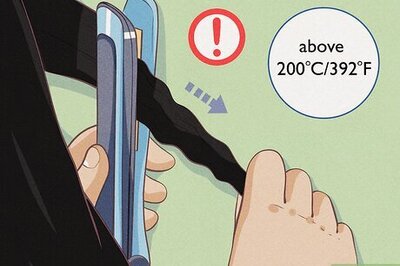
views
“+” Meaning in Betting
A plus sign (+) means that side is the underdog. When you see a plus sign (+) next to the name of a sports team or an individual player, it means that the sportsbook, or the organization running the betting lines, believes that that team is the underdog, and has a lower probability of winning. This means you’ll make more money if you bet on them and they win.
“-” Meaning in Betting
A minus sign (-) means that side is the favorite. A minus or negative sign (-) next to a sports team or player on a betting line means that that team is expected to win. If you bet on them and they do win, you won’t make as much money (but you’ll still make some).
Reading and Calculating American Betting Odds
Negative odds tell you how much to bet in order to win $100. For example, if you see a moneyline bet (which is simply a bet on whether or not a side will win) of -110, which is fairly common, you’d have to wager $110 dollars in order to win $100. This is because they’re the favored (-) team, so they have better chances, and more people are betting on them, which means a lower payout. Of course, you can bet however much money you want, but $100 is the standard by which bets are calculated and displayed.
Positive odds tell you how much profit you’ll make on a bet of $100. For example, if you read a moneyline odds of +200 and you wager $100, you’ll earn a total of $300, since you win your initial bet back, plus the $200 indicated by the probability. Your potential earnings are much better on a positive odds bet, since the odds are lower and fewer people are also betting that way.
Sportsbooks also integrate “spreads” to make bets more even. A “point spread” is like a handicap that ensures an uneven matchup still has a fairly equal chance to pay out in either direction. Spreads also use pluses and minuses, and when you see them, they indicate by how much a team must win or lose by in order for a bet to pay out. A team with a minus (-) in their spread is the favorite, and they’ll have to win by at least the specified number. For example, if a favorite team with a spread of +5 only wins by 3, their bets will not pay out. A team with a plus (+) in the spread is the underdog, and they’ll have to either win or lose by less than the spread to win the bet. For example, if an underdog with a spread of -2 loses the game by 1 point, their bets will still pay out.
How are betting odds determined by sportsbooks?
Odds are calculated based on past performance and existing bets. Sportsbooks (the organizations that host bets) look at a team’s record, as well as the other side’s record, to calculate their bets—this is the implied probability. Then, they factor in the existing bets to adjust for the probability of your own bet winning. If you bet on a favored team (+) that already has a lot of bets, your chances are good, but your payout is small, since the bets are divided among many bettors. Each sportsbook calculates their own bets with their own (often secret) formulas and speculations, so odds often look different from book to book.
Odds also factor in the “vigorish,” which is the buy-in. The “vigorish” or “vig” (a.k.a. the “juice”) is the amount of money a sportsbook charges for placing a single wager. The vig is how a sportsbook makes money, even when paying out high sums. This makes it so that you often have to wager more money than you expect to gain in order to make a profit on a bet. For example, normally you might expect to win $20 if you successfully bet $10 on a coin toss—earning back your bet, plus the other bettor’s bet. With a vig, though, if you wanted to win $20, you’d often have to bet $11 to earn back $9 for a total winnings of $20.
Betting on Plus-Minus Odds
Sign up for an online sportsbook that holds moneyline bets. There are a number of online betting sites, like DraftKings, Bovada, or Yahoo! Sportsbook. Register for one of these sites using your email address. They may ask for additional information like your credit card or bank account numbers, social security number, and birth date. Before you sign up, make sure sports betting is legal in your region. Most sites will tell you if it’s legal when you input your location when you sign up.
Browse for a sporting event to place a bid on. Use the menus on the site to navigate to your preferred sport, then browse the list of upcoming games that are open for bets. Once you find a game you’re interested in, click on it to select it.
Pick which side to bet on, and how much money to bet. Use the site’s interface to select your preferred team, and how much you want to bet on them. Remember: favorite teams will have lower payouts, while underdogs will have higher payouts. No matter who you choose, they have to win for you to get a payout! The most common bets are win/lose moneyline bets, like those described in this article, but there are many other ways to bet. If a website offers other betting types, it’ll often explain the rules and conditions. To start, make smaller bets, until you get a feel for the process and your luck.
Follow the game to see if you win your bet. Half the fun of sports betting is watching the game! Tune in to the event and follow along. Most sites will automatically pay out if you win, or withdraw money if you lose. They may ask for the money up-front when you make the bet, but this isn’t always the case.
Plus & Minus Odds in Common Sports
NFL & NBA With these leagues, betting is fairly straightforward, with the moneyline acting as the primary competition—whether or not a team loses, sometimes balanced with a point spread. It’s common to see odds of +/- 110 here.
MLB Things look a bit different in baseball, since points consist of runs and aren’t as numerous. Here, the spread and odds will often be noted with the label “Run Line,” and the spread will sometimes have half runs.
NHL Similar to the MLB, hockey has a different odds label, “Puck Line,” with common half-point spreads.
Golf Since golf features many individual players all competing for the top spot, you’ll be betting on an “outright winner moneyline.” Here, odds often look much different from other sports, with numbers in the thousands, but the principles remain the same.
UFC UFC odds are much more volatile, since a match can be decided with a single punch. There’s still a moneyline, but it’s common for odds to be much further apart.
Understanding Decimal Odds
Decimal odds show probabilities as decimal numbers. This is the most straightforward system, and shows how much money to the dollar you’d make on your bet. A favored team has a decimal below 1.00, and an underdog has a decimal above 1.00. Find your potential winnings by multiplying your bet by the decimal, then adding back your initial bet. For example, if you bet $100 on a favored team with 0.8 odds, you’d make $80, plus $100, for a total of $180. This system is widely used outside the US, and especially used in Europe.
Understanding Fractional Odds
Fractional odds show the probabilities as fractions. Fractional odds are fairly straightforward. A team with a better chance of winning will have a lower numerator (first or top number) than denominator (second or lower number), and a team with a lower chance will have a higher numerator than denominator. Find your potential payout by multiplying your bet by the numerator, dividing it by the denominator, then adding back your initial bet. For example, if you bet $200 on an underdog team with 5-4 odds, find your payout with the following equation: (200 * 5) / 4 = 250, + 200 = $400. Fractional odds are mostly used outside the US, and are common in horse racing.
Other Common Betting Terms
Chalk A chalk is a favored team that’s expected to win in a given matchup. Example: “He prefers to play it safe, so he only bets on chalks.”
Even money This is when the odds are even, at 50-50, and so however much money you bet is also how much additional money you’ll win. Example: “There’s even money on this NFL game. Anyone could take it.”
Hedging Hedging is when you bet against your original bet. Bettors sometimes do this to protect themselves from big losses if the odds are against their original bet. Example: “Looks like they’re gonna lose. Good thing I hedged my bet.”
Pick ‘em A pick ‘em is a game that has no clear underdog or favorite. These games have no spread, but may still have unequal odds, depending on the sportsbook’s outlook. Example: “Looking at a real pick ‘em. I don’t know who to pick!”















Comments
0 comment